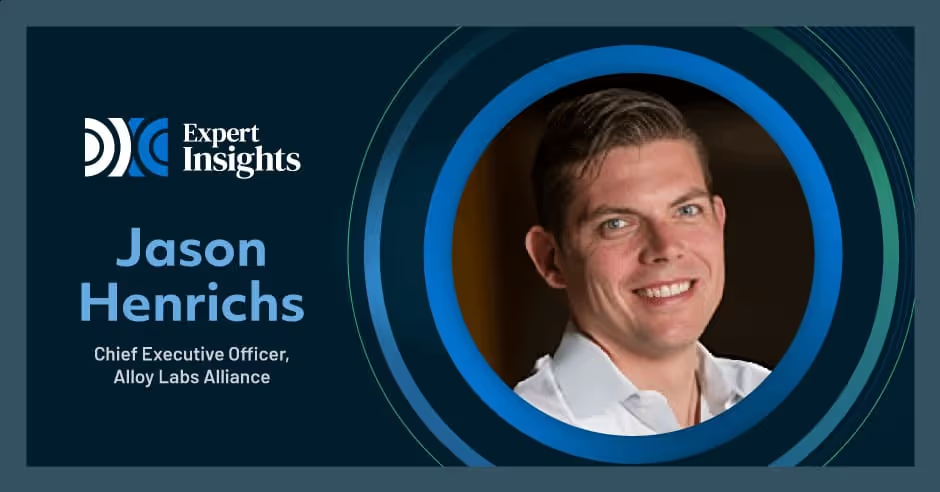
Jason Henrichs of Alloy Labs talks with Expert Insights host Joe Welu about the state of fintech in 2022. Alloy Labs interacts with many banks that are in the middle stages of digital transformation, and Jason outlines opportunities for the future of banking institutions growing to fit the modern needs of customers.—
Is Fintech Softening? With Jason Henrichs
Here’s another episode of the show where we get together to talk about leadership and innovation in modern banking and lending. In this episode, I am joined by a very bright and brilliant guy, Jason Henrichs, Founder and CEO of Alloy Labs. Jason is recognized across banking and FinTech as an innovator across financial services, creating new business models, and using technology to drive change. He has experience as a Founder, venture capitalist, great enterprise executive, board member, trusted advisor, and startup mentor. He co-hosts a great podcast, Breaking Banks, the number one global FinTech radio show and podcast, as well as his own podcast, Fintech 5, on Provoke.fm. Jason, it’s good to be with you again. How are you doing? I am good. I was jealous of the episode of Breaking Banks that you and JP did. It sounded phenomenal. I was bummed it didn’t get to be me talking to my buddy, Joe. It was a good time. I appreciate the opportunity. I want to get right into it and talk about a topic I’m hearing a lot about, and maybe you are as well. Is FinTech softening? What’s happening? Markets are getting clobbered in some cases. What’s your take? The question is such a timely one because there are a bunch of macro trends that we don’t have to go into with inflationary fears, the threat of nuclear wars causing turbulence, and the broader markets. I don’t think this is a trickle-down effect. It maybe amplifies it. Part of what we’re seeing is that there was a bit of a Ponzi scheme in funding. Whereas, how fast can I raise and raise more in this idea of bubbling valuations pulled the next round behind it like, “I need to raise in a bigger round and at a higher price in a unicorn status.” There’s so much capital sitting on the sidelines funneling the whole thing that even the insiders were willing to prop up valuations. What we’re seeing now is the a-ha moment of, “I actually have to solve undifferentiated problems.” The one you can pick on is if you look at the neobanks. There’s a neobank for everything, like the neobank for people who use their left hand when it’s a full moon. Is that a need that’s actionable? On the flip side, it’s easy for banks to point out and go, “This is why this whole FinTech thing was overblown is because we focus on cost-cutting measures.” You can’t cost-cut your way to success. What we’re going to find in between is a happy medium. The FinTechs are under pressure to rethink, “How do I deliver value?” Banks are challenged to figure out, “What do I do that is unique?” That’s where we’re going to see the goodness happen. In some sense, I’m disappointed. Dan O’Malley and I cofounded Perkstreet back in 2008. Shamir Karkal was one of the cofounders of Simple, and I talked about this. We’re a couple of years later, and it’s frankly pretty disappointing. Neobanks can get you your paycheck two days earlier. That’s it? That’s what you guys came up with? When the banks are challenged to figure out what they can do that is unique, that's where we're going to see the goodness happen.You’re not far off in some cases. That’s a big hook. That’s one of the things these guys are betting a lot of capital on that they’re going to be able to build a lasting business on that differentiation. Under pressure, to build on that, this is where the super exciting things happen. On our investment side, we’re looking at several deals now that fundamentally rethink the business model and the value proposition on both sides, both as a supplier and as the consumer of their products, in ways that are just much more fundamental. When you’re in this race to the top, it’s about eyeballs in the first boom-bust. It’s all about growth in a higher valuation. You don’t necessarily focus on those hard things. You focus on the easy things that feel like low-hanging fruit, but they turn out to be vanity metrics. You’re not really focusing on, “How do I go out and build sustaining relationships with these customers that are profitable?” They’re going out and acquiring a bunch of consumers that may or may not be able to drive a lot of profitability long-term. What you’re saying is, when things come under pressure, now you’re going to see where value and differentiation are going to happen. Is that what you’re saying? If you look at some banks, let me scoff at Chime and say I want their low-value customers, except Chime has gone out and rethought how they acquire customers, so they’re not paying the cost that a bank is, and they’ve thought about how they deliver on that. Under the covers, it’s a good relationship. It’s just not one the bank is prepared to support because the banks and credit unions oftentimes are stuck in, “This is what we do and how we do it,” without rethinking, “What do I do? For whom that’s unique that they’re willing to pay me a premium or they’re stickier?” That is not a long-term strategy. That makes total sense. You’re an interesting guy to talk to because you are at ground zero for a lot of innovation. You’re investing in FinTechs. Through Alloy Labs, you get a chance to interact with a lot of banks that are in the middle of various stages of digital transformation. You see both sides of it. I would love to hear a little about how the banking world we’re a part of and the conversations that we end up happening is the whole digital transformation theme. We see a lot of organizations getting to the backside of some of those projects and saying, “What did we get? What did we improve?” Do you see that? Is it showing up more? We’ve been seeing it from savvy organizations for a longer time. I’ll tell this vignette. This was several years ago, but it’s just as true. I had taken a red-eye from Boston to Seattle to meet with a relatively large bank out there. The CEO was like, “We tried innovation once, and it didn’t work.” I was like, “Why did you just fly me across the country?” If that’s the case, I’m like, “As long as I’m here, I might as well ask a bunch of questions. What did you try?” “We tried CRM.” I’m like, “What did you try with CRM?” I won’t name the name. It was not Total Expert. I’m like, “That’s interesting.” When they said it didn’t work, I thought, “Did they go for some startup? Did they try and build it themselves?” which you shouldn’t do. I’m like, “What isn’t working about it?” They’re like, “We’re not seeing any value.” I’m like, “What are you doing with it?” “We implemented this vendor.” You didn’t do anything different. You digitized a poor process, so now you’re doing bad things faster. Good for you. In some cases, bad behavior. They already have customer-facing people that don’t have great habits anyway. Now you’re just going to track those poor habits. It had gotten so bad that the executive sponsor who’s under fire who said, “We need CRM,” went and threatened everyone that if they weren’t uploading all of their contacts and their activities by Friday at 5:00, they’d be fired. I don’t know if this is just myth or lore around it, but he even turned to one of their biggest producers and was like, “Even you could be fired.” Basically, all businesses stopped at noon on Fridays for people to take their paper processes and upload them into something that no one else was doing. Part of the challenge is we need to rethink the model. Data and analytics are the most powerful tools that a lot of FinTechs use. Incumbent financial institutions, we’re used to locking that up. It’s like, “It’s valuable. We must keep it safe. We don’t use it for anything.” There’s a creepy extreme you can go to with this, but banks will say all the time that their unique competitive advantage is their relationship with their customers. This is mistaking personable with being personalized. When we lived in Chicago, Lola, who was asleep under the desk, knew every Chase branch within a two-mile radius because they all had dog bones. I hope Lola’s the dog and not your daughter. It’s the dog. My daughter can tell you which banks have candy. A five-year-old is well aware of that. Every time we walked in, they would always offer me a loan. How many times have I said no to the loan? Here’s what I want. I want offers that matter to me. I want you to use my data and tell me about a product or a service or something I could do that’s going to add value to my life. That’s how you personalize something for me and build my relationships. I like to pick on Amex. They do a phenomenal job in most things. When I get my, “We pick these offers just for you” email, the only reason I open it is so that I can get a good laugh of, “This is what you think I’m interested in?” What transactions are you looking at that you think this is what I want?

I’m a fan of all things marketing and customer engagement when it comes to financial services. I always look at those things, too. It is interesting. You touched on something that I want to drill in on a little bit. That is data and analytics. The FinTechs do a great job at using that. Correct me if I’m misquoting you. The banks have typically been doing a lot of that stuff, particularly some of the larger institutions. It’s been this secretive private thing where they keep all of the analytics and data in one place and don’t necessarily drill that into the business processes where somebody is actually taking care of a customer that, if they have that insight, could have a different conversation.
We need to free the data, which means you need to be able to pull it out of silos and, more importantly, get it clean into the hands of people and then train the people. This is as much a cultural issue. One of our members at Alloy Labs, the head of analytics and I were having this conversation. Their chief banking officer kept asking for these reports.
He was like, “What are you looking for?” She’s like, “The CEO says we need to be more data-driven.” He goes, “One, you don’t understand what data and analytics really are. This is not an old-school management information system. Let me give you some dot matrix, green and white striped paper. You got to tell me what you’re looking for. What kind of insight? Let me go test something.” Just generating reports doesn’t tell you what to do.
There are two approaches to this. There is the discovery phase, which is probably a little complex for a lot of banks to jump straight to, but into that discovery, let me go through some machine learning against the dataset, see what clusters, and then investigate what falls out of it. I don’t know what I’m searching for or if I’ll even find anything. That’s probably a bridge too far for a lot of the banks reading to start.
There’s also this confirmatory hypothesis testing. You need to get in the customer’s head here. What would make their life better in this data? Then let me go set up a test so that I can go do this. This is one of the things that is so valuable in a platform like Total Expert. You come with a whole bunch of user journeys out of the box, but your ability to manipulate and create new user journeys is to test, continually optimize, and look at what data falls out of the bottom. I know this is how groups of the Alloy Labs members that are Total Expert customers use it. If I do it this way, is that better or worse in performance than what I saw elsewhere?
You need a platform. You can’t afford to build your own. You can’t use something hardwired because the cost of experimentation needs to be dropped. Otherwise, you need to do this big ROI. It’s a big lift, it needs to integrate into my core, and it’s going to take us six months to implement. That’s too expensive. You’re only going to do something that’s safe.
I had a conversation with one of our large bank customers, and they’re using us for part of the business and not another part of the business. It was around that speed to market and speed to be able to iterate in testing a different communication, different journey essentially. I won’t name the vendor, but they have 4 or 5 dedicated developers. Every time they want to do something, they got to put it into a queue and bring on developers. By the time they can iterate and get feedback in the form of what happened, it’s 4, 5, 6 months down the road, and we’re just like, “The pace of progress is important for you guys right now.” At least, that’s how we think about it. You agree, I’m assuming.
A big part of this is there’s got to be a cultural change. That cultural change has to be modifying what we did is not bad that is positive because the likelihood that you hit the hole-in-one right out of the gate is so low. If you don’t go back and continue to modify and optimize, you’re squandering a huge opportunity for a sunk cost. The incremental cost of continuing to test and learn and optimize is low. That’s not an admission of failure. That’s a growth mindset of, “We’re going to do some stuff. We’re going to figure it out. It didn’t work as well as what we were doing, so let’s revert back to what we were doing.”
Do you think there are a lot of banks and credit unions that struggle organizationally to have a true growth mindset when it comes to evolving?
There’s a reason I still get to give that talk both on stage and with bank boards and management teams. I can tell things are lightening up. I’ve done it three times in a month, including at one of the big banking schools. I spent an entire day talking about how we teach bankers to have a growth mindset. The biggest challenge is, if you look at our business around lending, it is not about managing risk so much as we’ve gotten into this world where we try and eliminate risk. Not often do you point to the corner office and see the CEO, who almost always has come up through the lending operation in some form or fashion. Remember when Joe had that spectacular failure? That whole strip mall idea was brilliant.
That thing tanked, and we lost a bunch of money.
We gave everyone a trophy, and that was good. Culturally, we struggle with a growth mindset. Now you’re talking about a business that tries to control losses. It’s natural to have a selection bias for people who have a fixed mindset. If we tease them apart, these are two different things. For our core business, we’re not saying, “Anything goes, let’s throw it against the wall.” No.
Safety and soundness matter, and processes matter, but around the edges, we need to be comfortable taking some risks and understanding that taking a risk is for the purpose of learning. That’s what true value is. It’s not a traditional ROI that we’re going to look at, and we’re like, “We’re going to go do this experiment. Over the next years, it’s going to generate $100,000 in revenue.” It’s probably not an experiment if you can forecast all of that.
Take risks for the purpose of learning.Share on X
If we look at it and say, “For a small cost of dollars and the potential downside risk associated with it, let’s assume it all goes bad, and we lose all those loans,” what’s the minimum amount we could test to say this is worth it? Once I have a platform and want to optimize my system, what number of leads in the mortgage business am I willing to risk to say, “What if we changed our onboarding and flipped it around that you could do an automated approval or a workflow?” We’re willing to do twenty of those mortgages and look at what falls out the other side. You’re recognizing the whole thing could blow up. That’s probably worth learning, and then you build your business case once you have data.
When you’re working with banks, credit unions, and some of the FinTechs out there that you guys work with, and you’re talking about transformation and projects, are you advising them on doing more proof of concepts, more tests, and more 90-day, 180-day type scenarios? Is that part of your advice package on a typical basis?
Alloy Labs operates a reverse accelerator. It’s reverse in the sense that what we’re accelerating is the development of new types of partnerships and what the use case is. Not about, “Let’s go teach a startup to be a better startup,” or even to go meet a bank. Let me give you a great example that came out of it. One of our four thematic areas is around healthcare for both small businesses and for consumers. Specific to consumers, we’ve been focused on aging tech.
One of our VC partners hasn’t been partnering with banks yet. They’re a direct-to-consumer platform called Carefull out of New York. What they do is help adult children or caregivers manage the financials of aging parents. They had started down this path of, “Can you actually map cognitive decline based on cognitive data?” It turns out you can. You start missing payments and doing double payments. It’s all of these other places that they can help highlight. Having lived with my parents when we first moved back to Minnesota, I can tell you that elder abuse is real. Their phone rings off the hooks.
What Carefull solves is that this is not just a lever you throw where Jason is on the outside to Jason is now with the full power of attorney. That’s what ended up happening, and it was not a smooth transition. There’s this gradual change where you’re moving from, “You have read access,” to now, “You have limited read-write access,” to, “You have full control,” over the span of ten-plus years. That’s the problem they solve. They came to the concept lab, and our banks were intrigued.
I’m intrigued. That sounds fascinating.
One of our smaller banks was all over it. They looked at this and were like, “We have an aging population base. It’s a huge issue for us.” Their approach was like, “Let’s play out what would a paid pilot look like for you. It’s not full integration. It’s going to get us the data we need.” For Carefull, they can prove that banks can use this and do something with it. They figured out what the minimum is for both sides to say this is a good fit. It worked stunningly well. Now they’re on the fifth iteration of it. Frankly, even after you’ve signed the long-term contract, you should still have a proof of concept mindset.
You’re learning. You’re constantly evolving.
This is not a core conversion where the project is done the day it goes live. It should be a perpetual proof of concept until you’re like, “This thing is just running and humming. There’s no more to be done. Let’s innovate on something else.” If you sign a three-year contract, you should probably think of that as twelve proofs of concept over that span of time.
It’s so mind-blowing when you think about it. It’s been driven in to a lot of the people in these organizations because maybe the cores and legacy technology that, “We’re going to buy technology, and that’s the destination. We turn it on, it works, and we don’t need to do anything.” That is not how your technology partners should be approaching.
I know you guys see that a lot. Here are a couple more questions here. You guys obviously see front and center, ground zero, a lot of digital transformation projects. If you had to pick a couple of key points of failure, and we’ve talked about some of this, where would you point most often are the failure points in some of these organizations when it comes to big digital transformation projects?
Two. The first one is always looking at cost savings. We love those cost savings because they’re the easiest to point to, “In our efficiency ratio, what’s the impact going to be in hard dollars saved?” Except not everything can be cost savings. You’re not going to cut your way to greatness, as I already mentioned. The other is there are just some foundational things that need to happen that you’re not going to attribute the ROI to. The two big ones are that you need to figure out data and how you free the data. Second, you need to figure out APIs. Those are two things that you cannot point to today and say, “Here’s what that direct impact is.” You need to go do it.
You have to do it.
The longer you wait, the worse it’s going to be. If your board says no, you need new board members.
It’s really that profound. If they’re not investing in freeing the data, having APIs set up, and those types of things, you’re sealing your own fate. It’s a question of time.
Exactly. One of the other places that banks overthink, “I need a full digital transformation strategy.” They’re going to spend so much time planning, and the world’s going to move so much further before they catch up. This was one of the big insights of our Robotic Process Automation Center of Excellence. This would be true of anywhere that you’re looking at, “Where are the places I can automate?” Don’t focus on the biggest impact things first. Start doing some of them. This was a big a-ha for several of the members. We did one in the labor savings that we’re able to redeploy and work on other things. We just kept finding the next easy things that quick hits added up a lot faster.

You can make tremendous progress on various projects when you take that mindset of, “Let’s find some quick wins, low-hanging fruit, and then do it again.” Before we went on the show here, we talked a little bit about banking as a service. You mentioned somebody starting a neobank for everything. Every imaginable unique person or group has a neobank. Where are we at with that trend? What are you seeing, and what are your thoughts?
The flip side is not only is there a neobank for everything, but there’s also a bank behind them willing to be the bank behind the neobank for everything. Finextra published a survey that 85% of banks said that they are going to do something in banking as a service in the next eighteen months. I find a couple of things astounding about this. Who are the 15% of banks that don’t want to and are willfully choosing not to? For the 85% of them, how are they going to get into it and do it in that timeframe? I don’t know that any bank would be accused of being fast and standing those things up. What this comes down to is a principle for both the neobank and the bank behind it. Strategically, what are you trying to accomplish?
There is not enough differentiation on either side in terms of what they’re doing to make this business model work. Fundamentally, I’ve said this before, and some people take umbrage to it. Interchange cannot be your business model. Interchange is going to go down. We’re going to see it begin to maybe not get all the way to zero, but it’s under pressure.
For people that don’t know what interchange is. It’s the fees that are charged when there are transactions.
It’s what the merchants pay that funds your awards program, which is a huge source of profitability for most banks. It’s the reason MasterCard and Visa exist. What we’re going to see is there are now alternatives. When Dodd-Frank was introduced, it put a cap on interchange fees for the biggest banks. There was no alternative for the merchants to not pay those fees for the banks than under $10 billion.
Guess what? There are now. The number of places you can go, and not only is it more convenient for you to say, “I’ll click out using Amazon. It knows my address and all of that.” That button exists in a whole lot of places. How often do you embed a payment method in your wallet for something? I can tell you and hope they don’t do this.
They would not have to give me very much at Starbucks to get me to link my routing and account number and turn that into an ACH. I already store money there. Why? It’s because it’s too inconvenient to like, “I was getting a latte for my wife, which quadruples the cost. I only had $4 in my Starbucks wallet. Now I need $25 based on everything she ordered.”
I keep $50 bucks in my Starbucks wallet that auto-loads. If they said, “Jason, if you know you were willing to do that to make it an ACH, you get one extra donut a quarter,” I’d do that for a donut. Are you kidding? I would switch to that. That’s where we’re going to see interchange begin to have pressure. Now, we’re going to get into this case. What’s the business model? The bank needs to be paid. The tech stack needs to be paid, and the neobank needs to be paid. Everyone needs to rethink their business model. In this new world, how do I operate?
Angela Strange of Andreessen Horowitz always said everything’s going to be a FinTech, which is true. If you are conducting commerce, you will, by definition. If you are buying, selling, or storing a value of some sort, you are becoming a FinTech. The threat to traditional banking is not these new startups coming in. It’s those that view the friction that we put into the system, whether it’s fees, time, or inconvenience. That’s what’s going to get taken out of the system.
There’s a reason, and it seems crazy that why would anyone go to Rocket Mortgage. It was more expensive. On average, 35 basis points are more expensive. Why would I go to Rocket Mortgage? I’ll tell you why. It’s because Jason’s problem that he’s solving is not how inexpensive the mortgage is. It’s called don’t lose the house. “I need to get a mortgage approved over a Saturday, and I can’t go into the community bank.” That’s the problem Jason’s solving for. I’ll just refi that later, but it is not, “Get mortgage.” It’s, “Don’t get divorced because you lose the house you’ve been dropping for over months.”
Don’t have your wife or spouse mad at you for losing the house.
While living in her in-law’s house. This was a very potent use case. You have to think about what that problem is and where it fits.
That’s very well said. I feel like we’re going to have to have another conversation and go deeper on those topics. Thank you, as always. Thanks for the time, Jason. I appreciate your thoughts.
Thanks, Joe.
Important Links
- Alloy Labs
- Breaking Banks – Apple Podcasts
- Fintech 5
- Provoke.fm
- Secret Sauce for Deeper Relationships & What’s So Nifty About NFTs – Previous Episode
- Carefull
About Jason Henrichs

I bridge the gap between large organizations and the fintech ecosystem to innovate in a highly regulated environment. My passion is solving problems that leave the world a better place, especially in financial services.
I’ve been a founder, venture capitalist, executive, board member, advisor, angel investor and mentor in the startup world for two decades.


